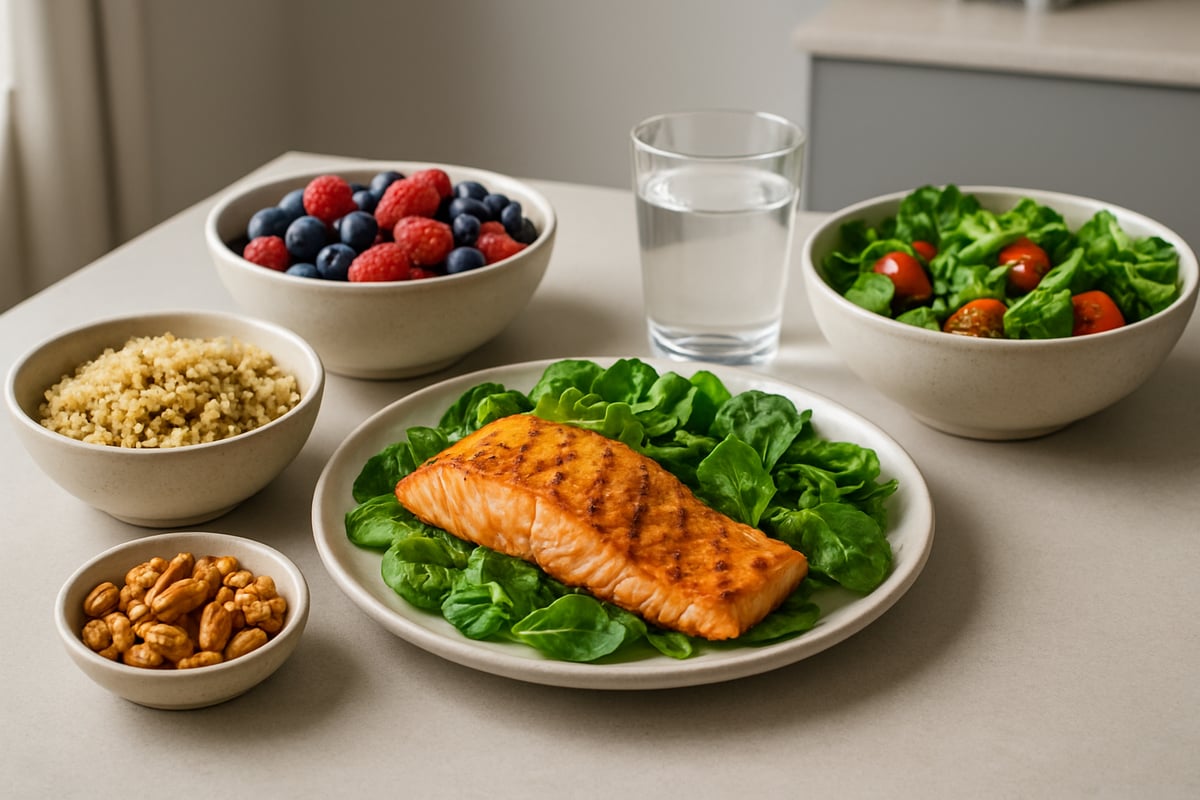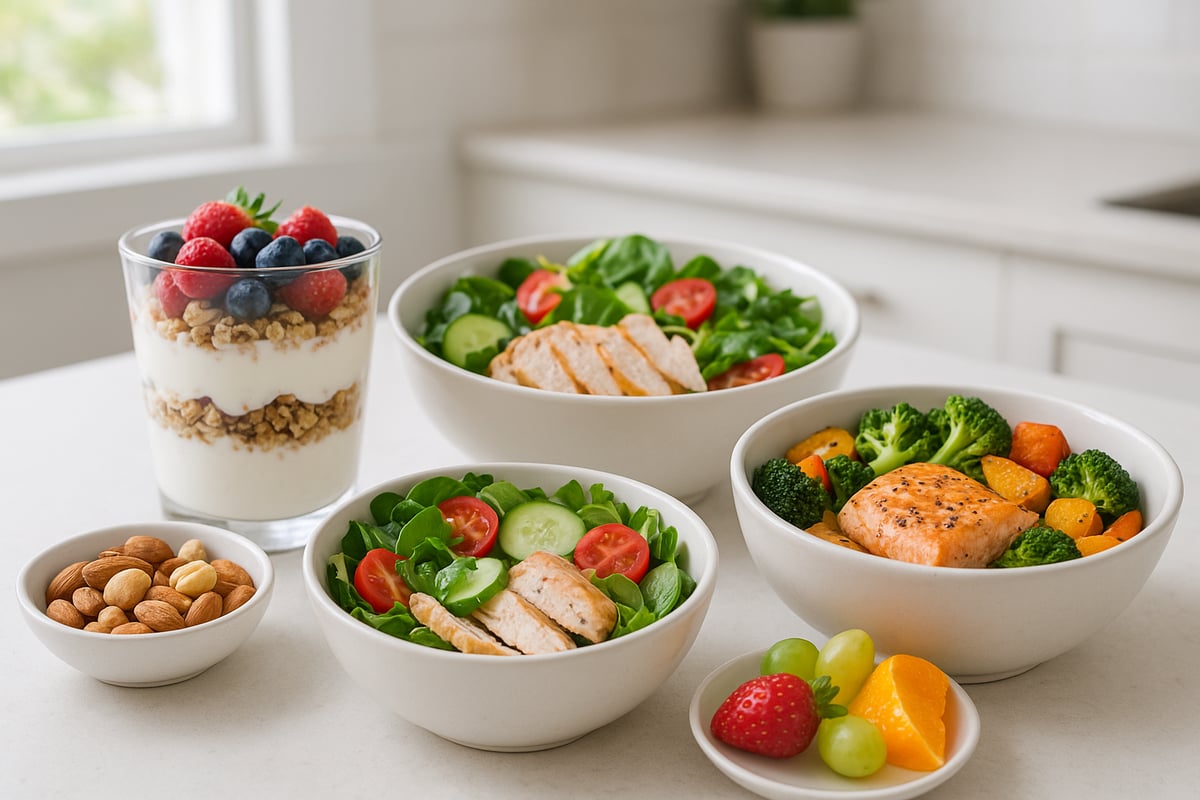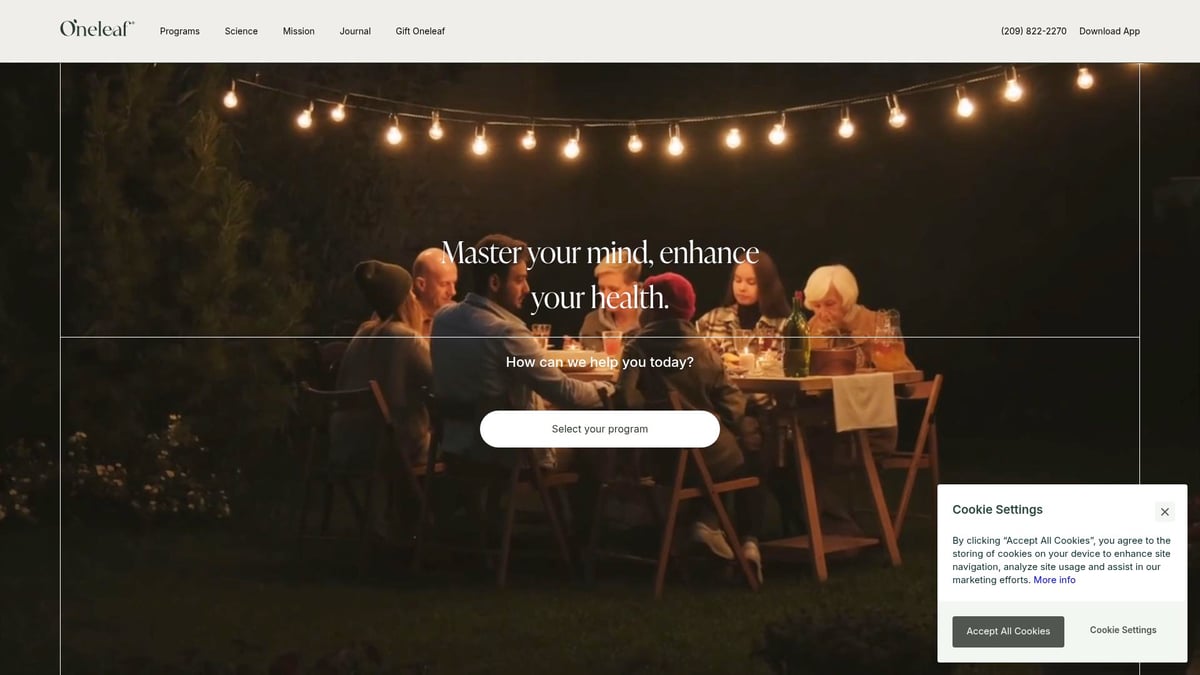As we approach 2025, the spotlight on balanced eating and personalized nutrition continues to grow. More people are seeking practical solutions for long-term health, making a 2000 calorie meal plan a go-to benchmark for healthy adults.
This comprehensive guide explores how to create a balanced 2000 calorie meal plan using the latest science and expert insights. You will discover how to assess your calorie needs, break down essential nutrients, and build meals that fuel your body for optimal wellness.
We will share sample meal plans, customization tips, and strategies for lasting habits. Ready to take control of your nutrition? Explore healthy meal planning resources and actionable steps for balanced eating in 2025.
Understanding the 2000 Calorie Standard
Balanced eating starts with understanding why the 2000 calorie meal plan is considered the gold standard for healthy adults. As we move into 2025, more people are seeking clarity on what this benchmark means and how it fits into their daily lives. Let’s break down the science and trends shaping the 2000 calorie meal plan, so you can use this framework with confidence.

Why 2000 Calories Is the Benchmark
The 2000 calorie meal plan is rooted in the 2020–2025 Dietary Guidelines for Americans, which set this number as a reference point for nutrition labels and healthy eating patterns. This guideline helps consumers compare foods and plan meals for optimal energy and nutrient intake.
For most healthy adults, a 2000 calorie meal plan provides enough calories to support normal activity, maintain weight, and deliver essential nutrients. However, individual needs can vary based on age, gender, activity level, and health goals. For example, adult women may need anywhere from 1,600 to 2,400 calories per day, while men often require 2,000 to 3,000. Understanding these ranges is crucial for effective meal planning and portion control.
Who Should Follow a 2000 Calorie Meal Plan?
A 2000 calorie meal plan is ideal for healthy adults with moderate activity levels, but it’s not a universal solution. Each person’s requirements can differ based on metabolism, lifestyle, and specific health needs. For instance, pregnant women, teenagers, athletes, and older adults often need to modify their intake to support growth, performance, or age-related changes.
If your goal is weight loss, reducing your daily intake from a higher maintenance level to a 2000 calorie meal plan can result in gradual, sustainable fat loss. For example, cutting from 2,500 to 2,000 calories may lead to about one pound of weight loss per week. Always consult a healthcare provider or registered dietitian before making significant changes to your meal plan to ensure it’s tailored to your unique needs.
How Calorie Needs Change in 2025
As we approach 2025, advances in nutrition science and technology are transforming how we understand and manage our calorie needs. Wearable devices and health apps now allow for precise tracking of movement, metabolic rate, and even sleep, all of which influence how many calories you require daily.
Greater awareness of genetics, gut health, and lifestyle factors is helping individuals personalize their 2000 calorie meal plan for maximum effectiveness. Digital health tools make it easier to adjust meal plans in real time, ensuring you stay aligned with your wellness goals. Competitor articles highlight the rise of personalized nutrition, making the 2000 calorie meal plan more adaptable than ever before.
The Role of Mindful Eating and Behavior Change
Mindful eating is gaining momentum as a key trend in healthy living for 2025. Incorporating mindfulness into your 2000 calorie meal plan can help reduce overeating, improve satisfaction, and support better digestion. Studies show that people who practice mindful eating are more likely to maintain a healthy weight and develop a positive relationship with food.
Behavior change is also essential. Neuroscience-based approaches, such as guided habit formation and conscious meal planning, make it easier to stick with your 2000 calorie meal plan for the long haul. Simple strategies like eating slowly, savoring flavors, and minimizing distractions can transform your eating habits, making balanced nutrition more enjoyable and sustainable.
Building Blocks of a Balanced 2000 Calorie Meal Plan
Creating a balanced 2000 calorie meal plan is all about understanding the key building blocks that support health and wellness. By focusing on the right macronutrient ratios, essential micronutrients, fiber, hydration, and food quality, you can optimize your nutrition for energy and long-term success. Let’s break down each component and see how they fit together as you work toward your health goals in 2025.

Macronutrient Distribution: Protein, Carbs, Fats
A well-designed 2000 calorie meal plan starts with balanced macronutrient ratios. Experts recommend 45–65% of calories from carbohydrates, 10–35% from protein, and 20–35% from fats. This balance provides steady energy, supports muscle maintenance, and keeps you satisfied throughout the day.
For example, your daily intake might include 225–325 grams of carbs, 50–175 grams of protein, and 44–78 grams of fat. Choosing high-quality sources, such as lean meats, whole grains, and healthy oils, is essential. For more inspiration on nutrient-dense foods, check out these 10 foods to supercharge metabolism.
Want to track your intake more effectively? Explore digital meal planning tools that help you monitor macronutrients and stay on target.
Essential Micronutrients for 2025 Wellness
Micronutrients are the unsung heroes of any 2000 calorie meal plan. Focus on vitamins and minerals like vitamin D, calcium, magnesium, iron, and potassium to support immunity, bone health, and mood.
Incorporate foods rich in these nutrients:
- Leafy greens (spinach, kale)
- Dairy or fortified plant milks
- Lean meats, fish, and eggs
- Whole grains and legumes
Staying consistent with a variety of micronutrient sources can be easier with healthy meal planning resources that offer tailored grocery lists. For more expert tips, read dietitians' advice for healthy weight loss.
Fiber, Hydration, and Gut Health
Fiber is a cornerstone of a successful 2000 calorie meal plan, with 25–38 grams per day supporting digestion, weight control, and heart health. Good sources include beans, whole grains, fruits, and vegetables.
Hydration is just as vital. Aim for regular water intake and include water-rich foods like cucumbers and berries. Gut health matters too, so add fermented foods, prebiotics, and probiotics to your meals.
Stay on track by using meal prep strategies that help you plan fiber-rich snacks and hydration reminders. For an in-depth guide, review 8 essential tips to choose the right weight loss program.
Portion Sizes and Food Quality
Mastering portion sizes is key for a 2000 calorie meal plan. Use visual cues, such as dividing your plate or the hand method, to prevent overeating. Prioritize whole, minimally processed foods for maximum satiety and nutrient density.
Consider these swaps:
- Whole grains instead of refined grains
- Lean proteins over processed meats
- Fresh produce over packaged snacks
Want more support? Try portion control tips and learn how to build meals that truly satisfy you. For more, visit 10 foods to supercharge metabolism.
Adapting to Dietary Preferences and Restrictions
A 2000 calorie meal plan is highly adaptable. Whether you’re vegetarian, vegan, gluten-free, or low-carb, you can personalize your meals for your needs.
Examples include:
- Swapping lentils or tofu for meat
- Using dairy alternatives like almond or oat milk
- Choosing gluten-free grains, such as quinoa or rice
Stay allergen-aware by checking labels and using customized nutrition tools for your specific requirements. For advanced personalization, explore healthy eating articles for more ideas.
Sample 2000 Calorie Meal Plan for 2025
Creating a balanced 2000 calorie meal plan for 2025 means combining science, variety, and practical strategies. Below, discover a detailed daily menu, tailored breakfast, lunch, dinner, and snack ideas. Each suggestion prioritizes nutrient density, flavor, and flexibility. Use these examples as a foundation to build your own healthy routine, drawing on healthy meal plan inspiration to keep your meals exciting and effective.

Day-by-Day Meal Plan Example
Start with a sample 2000 calorie meal plan to visualize how a balanced day can look:
Breakfast:
- Greek yogurt parfait with fresh berries, honey, and granola
- 1 cup black coffee or herbal tea
Lunch:
- Grilled chicken salad with mixed greens, cherry tomatoes, quinoa, and olive oil vinaigrette
- Whole grain roll
Snack:
- Apple with 2 tablespoons almond butter
Dinner:
- Chili lime salmon bowl with brown rice, roasted broccoli, and avocado
Snack:
- Cottage cheese with pineapple chunks
Each meal and snack is thoughtfully portioned to keep the entire 2000 calorie meal plan on track. For more balanced eating resources, explore additional sample days and seasonal adjustments.
Breakfast Options: Start Your Day Right
The first meal in a 2000 calorie meal plan sets the tone for energy and satisfaction. Focus on high-protein, fiber-rich foods with whole grains and fruit.
Try these breakfast ideas:
- Overnight oats with chia seeds, banana, and almond milk
- Scrambled eggs with spinach and feta
- Smoothie bowl with Greek yogurt, mixed berries, and pumpkin seeds
Consider a Tex-Mex breakfast wrap or classic yogurt parfait if you want global flavors or a quick option. Rotate your choices to avoid breakfast boredom. For creative recipes and more healthy habits guide, check out Oneleaf’s expert advice.
Lunch Choices: Balanced and Satisfying
A midday meal in your 2000 calorie meal plan should deliver lean protein, whole grains, and lots of vegetables. This approach supports satiety and steady energy.
Smart lunch choices include:
- Caesar salad with grilled chicken, kale, and Parmesan
- Grain bowl with roasted sweet potato, black beans, and avocado
- Turkey and hummus wrap with mixed greens
Meal prepping on weekends can ensure you have ready-to-go options. Use portion control tools to keep servings aligned with your goals. For more inspiration, browse Oneleaf’s nutrition journal for seasonal lunch ideas.
Dinner Ideas: Nutrient-Dense and Flavorful
Dinner in a 2000 calorie meal plan is an opportunity to enjoy nutrient-dense foods and global flavors. Focus on lean meats, fish, plant-based proteins, and a rainbow of vegetables.
Try these dinner recipes:
- Chili lime salmon bowl with brown rice and roasted veggies
- Chicken fried rice with peas, carrots, and scrambled egg
- Lentil curry with sautéed spinach and brown rice
Incorporate herbs and spices for variety. For more personalized wellness support, find adaptable dinner recipes to suit your preferences. Oneleaf’s summer weight loss tips offer creative ways to keep dinners light yet satisfying.
Smart Snacks to Stay Energized
Snacks help maintain energy between meals and prevent overeating at main meals. Within a 2000 calorie meal plan, choose snacks that are filling but not calorie dense.
Snack ideas include:
- Protein snack pack (turkey, cheese, grapes)
- Almond flour crackers with hummus
- Fruit with a handful of walnuts
- Cheesecake base bar made with Greek yogurt and oats
Stay mindful of portions using smart snacking ideas. For mindful eating strategies, read about Mindful Eating and Weight Management, which can help reduce cravings and support digestion. For more snack inspiration, reference Oneleaf’s balanced eating resources.
A 2000 calorie meal plan can adapt to your tastes and needs. With daily variety, practical planning, and the right healthy meal plan inspiration, you can achieve balanced nutrition and lasting wellness in 2025.
Customizing Your 2000 Calorie Meal Plan
Creating a 2000 calorie meal plan that fits your unique goals and lifestyle is essential for long-term success. Customization ensures you get the right balance of nutrients, flavors, and flexibility as your needs evolve. In 2025, personalization is more accessible than ever, empowering you to take control of your nutrition journey.
Tailoring for Weight Loss, Maintenance, or Muscle Gain
Your 2000 calorie meal plan should align with your specific goals, whether you want to lose weight, maintain your current physique, or build muscle. For weight loss, consider creating a calorie deficit by slightly reducing portion sizes or choosing lower-calorie foods, always ensuring you stay nourished. Maintenance requires balancing your intake with your activity level. If muscle gain is your aim, increase your protein within the 2000 calorie meal plan and pair it with resistance training.
- Adjust macronutrient ratios: more protein for muscle, fewer carbs for fat loss.
- Monitor progress and tweak your plan as needed.
- Use healthy meal planning resources to explore food swaps and balanced recipes.
Remember, gradual changes and consistency are more effective than drastic restrictions.
Adapting for Dietary Preferences and Allergies
Personalizing your 2000 calorie meal plan is crucial if you follow a vegetarian, vegan, gluten-free, or allergy-sensitive diet. Swap animal proteins for plant-based sources like lentils, tofu, or tempeh. For gluten-free needs, choose grains such as quinoa, brown rice, or certified gluten-free oats. Always check for hidden allergens when shopping.
- Try dairy alternatives like almond or oat milk.
- Rotate in seasonal produce for variety and nutrients.
- Consult Oneleaf’s nutrition journal for expert advice on inclusive meal planning.
For more recipe inspiration and allergen-friendly ideas, visit this collection of healthy eating tips.
Using Technology for Meal Planning in 2025
Technology is revolutionizing how we design and track a 2000 calorie meal plan. Wearables and apps now monitor your calorie intake, macronutrient ratios, and even eating speed in real time. According to an EMG-Based Eating Behavior Monitoring Study, wearable devices can help develop mindful eating habits by providing instant feedback.
- Use barcode scanners for accurate food logging.
- Try AI-powered platforms that suggest recipes based on your preferences and goals.
- Create digital grocery lists to streamline shopping.
For the latest tools and digital resources, explore smart meal planning solutions.
Mindful Eating and Habit Formation
Integrating mindful eating practices into your 2000 calorie meal plan can help you recognize hunger cues, reduce emotional eating, and enjoy meals more fully. Slow down, savor each bite, and remove distractions during meals. Building healthy habits is a gradual process that benefits from consistency and positive reinforcement.
- Set regular meal times to support your routine.
- Use habit-tracking apps to monitor progress.
- Find actionable strategies in Oneleaf’s mindful eating guide for long-term results.
For extra support with mindful eating, check out practical habit change tips.
Neuroscience-Based Habit Change: The Oneleaf Approach
Lasting change with your 2000 calorie meal plan starts in the mind. The Oneleaf approach uses neuroscience-based audio sessions to rewire your brain, making healthy choices feel natural and automatic. By targeting habits at the subconscious level, you can reduce cravings and boost motivation for balanced eating.

- Experience real-life results from users who have built sustainable routines.
- Access sessions designed to help you stay consistent with your goals.
- Read more about the science behind habit change in Oneleaf’s expert articles.
Ready to take the next step? Discover personalized support and science-backed strategies to make your 2000 calorie meal plan truly your own.
Balanced Eating Tips for Success in 2025
Building a successful 2000 calorie meal plan in 2025 means more than just counting calories. It requires intentional shopping, smart meal prep, and staying up to date with nutritional science. By following expert strategies, you can enjoy balanced eating that supports your health goals, keeps meals interesting, and helps you stay consistent all year long.
Grocery Shopping and Meal Prep Strategies
Effective meal prep starts with a well-planned grocery list. Shop the perimeter of the store for whole foods like fresh produce, lean proteins, and whole grains. Batch cooking staples and prepping snacks ahead of time streamlines your week and makes sticking to your 2000 calorie meal plan much easier.
Try prepping easy breakfast bowls or salad jars for grab-and-go options. Use healthy meal planning resources to find new recipes and keep your menus fresh. Pay attention to food labels and look for items that meet the updated FDA definition of "healthy", focusing on nutrient density and quality.
Eating Out and Social Situations
Dining out or attending social events does not have to disrupt your 2000 calorie meal plan. Review menus in advance, choose grilled or baked items, and ask for dressings and sauces on the side to control portions.
Practice mindful eating techniques like slowing down and savoring each bite. This approach helps you recognize fullness cues and avoid overeating. Splitting entrees, choosing smaller plates, and filling up on vegetables are smart ways to stay on track even when options are limited.
Overcoming Common Challenges and Plateaus
It is normal to face challenges on your 2000 calorie meal plan journey. Cravings, emotional eating, or hitting a plateau are common. Stay consistent, practice self-compassion, and focus on progress rather than perfection.
When setbacks occur, reframe your mindset and seek support from friends or online communities. Access science-backed habit change support for guidance and motivation. Tracking your meals and celebrating small wins can help you push through difficult moments and maintain momentum.
Staying Motivated and Accountable
Motivation can ebb and flow, but building accountability into your 2000 calorie meal plan increases your chances of long-term success. Set realistic, measurable goals and track your achievements regularly.
Join a wellness challenge or connect with a support network to stay inspired. Celebrate non-scale victories, like improved energy or better sleep, and remember that lasting change comes from consistency and positive habits.
Leveraging the Latest Nutrition Science
Stay informed about nutrition trends and scientific advances that can enhance your 2000 calorie meal plan. Personalized nutrition, gut health, and digital tracking tools are shaping the future of healthy eating.
Follow reputable sources like Oneleaf’s nutrition journal to keep your knowledge up to date. Incorporate cutting-edge strategies and evidence-based tips from trusted platforms to ensure your meal plan remains effective, enjoyable, and sustainable.
Frequently Asked Questions About the 2000 Calorie Meal Plan
Navigating a 2000 calorie meal plan can raise plenty of questions, especially as nutrition science evolves. Below, you’ll find expert answers to the most common concerns, along with links to trusted resources and actionable strategies for lasting success.
Is 2000 Calories Right for Me?
Determining if a 2000 calorie meal plan suits your needs starts with understanding your body and lifestyle. Most healthy adults find this intake aligns with their energy and nutrient requirements, but factors like age, activity level, and health goals play a major role.
Consider using online calculators or apps to estimate your needs. If you’re unsure, consult a registered dietitian or doctor before making changes. For more guidance, see this expert guide on healthy habits.
Personalization is key. Explore personalized nutrition tools that help you adjust your plan for optimal results.
Can I Lose Weight on a 2000 Calorie Meal Plan?
Yes, weight loss is possible with a 2000 calorie meal plan, especially if your maintenance calories are higher. Creating a calorie deficit, usually by reducing intake by 500 calories daily, can lead to about one pound of weight loss per week for many adults.
Metabolism, activity, and medical conditions all influence your results. Using habit change tools can support your journey and help you maintain consistency.
For a deeper dive, check out habit change strategies to overcome plateaus and stay motivated.
How Can I Make My Meal Plan Sustainable?
A sustainable 2000 calorie meal plan should be flexible, enjoyable, and varied. Rotate recipes, try new cuisines, and allow for occasional treats to prevent boredom. Building healthy habits is easier with the right support.
Leverage science-backed meal planning resources for inspiration and accountability. Incorporate tips from Oneleaf’s healthy habits journal to stay on track.
Remember, consistency and self-compassion are just as important as calorie counting for long-term success.
What If I Have Dietary Restrictions or Allergies?
Adapting your 2000 calorie meal plan for dietary needs is simple with a little planning. Swap in dairy-free yogurts, gluten-free grains, or plant-based proteins as needed. Always read labels carefully, especially for hidden allergens.
If you need extra support, explore expert resources tailored to your preferences. Stay informed with allergen-aware meal planning tips and look for products that match your needs.
Personalization ensures your plan is both safe and satisfying.
As you look ahead to building healthier habits in 2025, remember that nutrition is deeply personal—what works for one person may look different for another. This guide has given you practical steps for creating a balanced 2000 calorie meal plan, but lasting change starts with understanding your unique needs and patterns. If you’re ready to make mindful eating second nature and want science-backed support for reaching your goals, let’s take the next step together. You can discover your personalized path to better habits and nutrition by taking a quick, insightful quiz right here: Start Quizz















